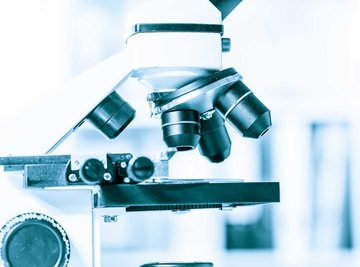
Ribosomes are highly diverse protein structures found in all cells. In prokaryotic organisms, which include the Bacteria and Archaea domains, ribosomes "float" free in the cytoplasm of cells. In the Eukaryota domain, ribosomes are also found free in cytoplasm, but many others are attached to some of the organelles of these eukaryotic cells, which make up the animal, plant and fungal worlds.
You may see some sources refer to ribosomes as organelles, while others assert that their lack of a surrounding membrane and their existence in prokaryotes disqualifies them from this status. This discussion assumes that ribosomes are in fact distinct from organelles.
Ribosomes' function is to manufacture proteins. They do this in a process known as translation, which involves taking instructions encoded in messenger ribonucleic acid (mRNA) and using these to assemble proteins from amino acids.
Overview of Cells
Prokaryotic cells are the simplest of cells, and a single cell virtually always accounts for the entire organism is this class of living things, which spans the taxonomic classification domains Archaea and Bacteria. As noted, all cells have ribosomes. Prokaryotic cells also contain three other elements common to all cells: DNA (deoxyribonucleic acid), a cell membrane and cytoplasm.
Since prokaryotes have lower metabolic needs than do more complex organisms, they have a relatively low density of ribosomes in their in, as they don't need to participate in the translation of as many different proteins as more elaborate cells do.
Eukaryotic cells, found in the plants, animals and fungi that make up the domain Eukaryota, are far more complex than their prokaryotic counterparts. In addition to the four essential cell components listed above, these cells have a nucleus and a number of other membrane-bound structures called organelles. One of these organelles, the endoplasmic reticulum, has an intimate relationship with ribosomes, as you'll see.
Events Before the Ribosomes
In order for translation to occur, there has to be a strand of mRNA to translate. mRNA, in turn, can only be present if transcription has taken place.
Transcription is the process by which the nucleotide base sequence of an organism's DNA encodes its genes, or lengths of DNA corresponding to a specific protein product, in the related molecule RNA. Nucleotides in DNA have the abbreviations A, C, G and T, whereas RNA includes the first three of these but substitutes U for T.
When the DNA double strand unwinds into two strands, transcription can occur along one of them. This does so in a predictable way, as A in the DNA is transcribed into U in mRNA, C into G, G into C and T into A. The mRNA then leaves the DNA (and in eukaryotes, the nucleus; in prokaryotes, the DNA sits in the cytoplasm in a single, small, ring-shaped chromosome) and moves through the cytoplasm until encountering a ribosome, where translation begins.
Overview of Ribosomes
The purpose of ribosomes is to serve as sites of translation. Before they can help coordinate this task, they themselves have to be put together, because ribosomes only exist in their functional form when they are actively operating as protein-manufacturers. Under resting circumstances, ribosomes break up into a pair of subunits, one large and one small.
Some mammalian cells have as many as 10 million distinct ribosomes. In eukaryotes, some of these are found attached to endoplasmic reticulum (ER), resulting in what is called rough endoplasmic reticulum (RER). In addition, ribosomes can be found in the mitochondria of eukaryotes and in the chloroplasts of plant cells.
Some ribosomes can attach amino acids, the repeating units of proteins, to each other at a speed of 200 per minute, or over three per second. They have multiple binding sites because of the multiple molecules that participate in translation, including transfer RNA (tRNA), mRNA, amino acids, and the growing polypeptide chain that the amino acids are being attached to.
Structure of Ribosomes
Ribosomes are generally described as proteins. About two-thirds of the mass of ribosomes, however, consists of a kind of RNA called, aptly enough, ribosomal RNA (rRNA). They are not surrounded by a double plasma membrane, as are organelles and the cell as a whole. They do, however, have a membrane of their own.
The size of ribosomal subunits is measured not strictly in mass but in a quantity called the Svedberg (S) unit. These describe the sedimentation properties of the subunits. Ribosomes have a 30S subunit and a 50S subunit. The larger of the two functions predominantly as a catalyst during translation, whereas the smaller operates mostly as a decoder.
There are about 80 different proteins in the ribosomes of eukaryotes, 50 or more of which are unique to ribosomes. As noted, these proteins account for about one-third of the overall mass of ribosomes. They are manufactured in the nucleolus inside the nucleus and then exported into the cytoplasm.
What Are Proteins and Amino Acids?
Proteins are long chains of amino acids, of which there are 20 different varieties. Amino acids are linked together to form these chains by interactions known as peptide bonds.
All amino acids contain three regions: an amino group, a carboxylic acid group and a side chain, usually designated the "R-chain" in the language of biochemists. The amino group and the carboxylic acid group are invariant; it is thus the nature of the R-chain that determines the unique structure and behavior of the amino acid.
Some amino acids are hydrophilic because of their side chains, meaning they "seek" water; others are hydrophobic and resist interactions with polarized molecules. This tends to dictate how the amino acids in a protein will be assembled in three-dimensional space once the polypeptide chain becomes long enough for interactions between non-neighboring amino acids to become an issue.
The Role of Ribosomes in Translation
Incoming mRNA binds to ribosomes to initiate the process of translation. In eukaryotes, a single strand of mRNA codes for only one protein, whereas in prokaryotes, an mRNA strand can include multiple genes and therefore code for multiple protein products. During the initiation phase, methionine is always the amino acid first coded for, usually by the base sequence AUG. Each amino acid, in fact, is coded for by a specific three-base sequence on mRNA (and sometimes more than one sequence codes for the same amino acid).
This process is enabled by a "docking" site on the small ribosomal subunit. Here, both a methionyl-tRNA (the specialized RNA molecule transporting methionine) and the mRNA bind to the ribosome, coming closer to each other and allowing the mRNA to direct the right tRNA molecules (there are 20, one for each amino acid) to arrive. This is the "A" site. At a different point lies the "P" site, where the growing polypeptide chain remains bound to the ribosome.
The Mechanics of Translation
As translation progresses beyond the initiation with methionine, as each new incoming amino acid is summoned to the "A" site by the mRNA codon, it is soon moved over to the polypeptide chain at the "P" site (elongation phase). This allows the next three-nucleotide codon in the mRNA sequence to call the next tRNA-amino acid complex needed, and so on. Eventually the protein is completed and released from the ribosome (termination phase).
Termination is initiated by stop codons (UAA, UAG, or UGA) that do not have corresponding tRNAs, but instead signal release factors to put an end to protein synthesis. The polypeptide is sent off, and the two ribosomal subunits separate.
References
- Washington University in St. Louis Biology Department: Organelles
- NCBI Bookshelf: The Cell: A Molecular Approach (2nd Edition): Translation of mRNA
- British Society for Cell Biology: Ribosome
- LibreTexts Biology: Ribosomes
- Scitable By Nature Education: DNA Transcription
- LibreTexts Chemistry: Introduction to Amino Acids and Proteins
About the Author
Kevin Beck holds a bachelor's degree in physics with minors in math and chemistry from the University of Vermont. Formerly with ScienceBlogs.com and the editor of "Run Strong," he has written for Runner's World, Men's Fitness, Competitor, and a variety of other publications. More about Kevin and links to his professional work can be found at www.kemibe.com.
